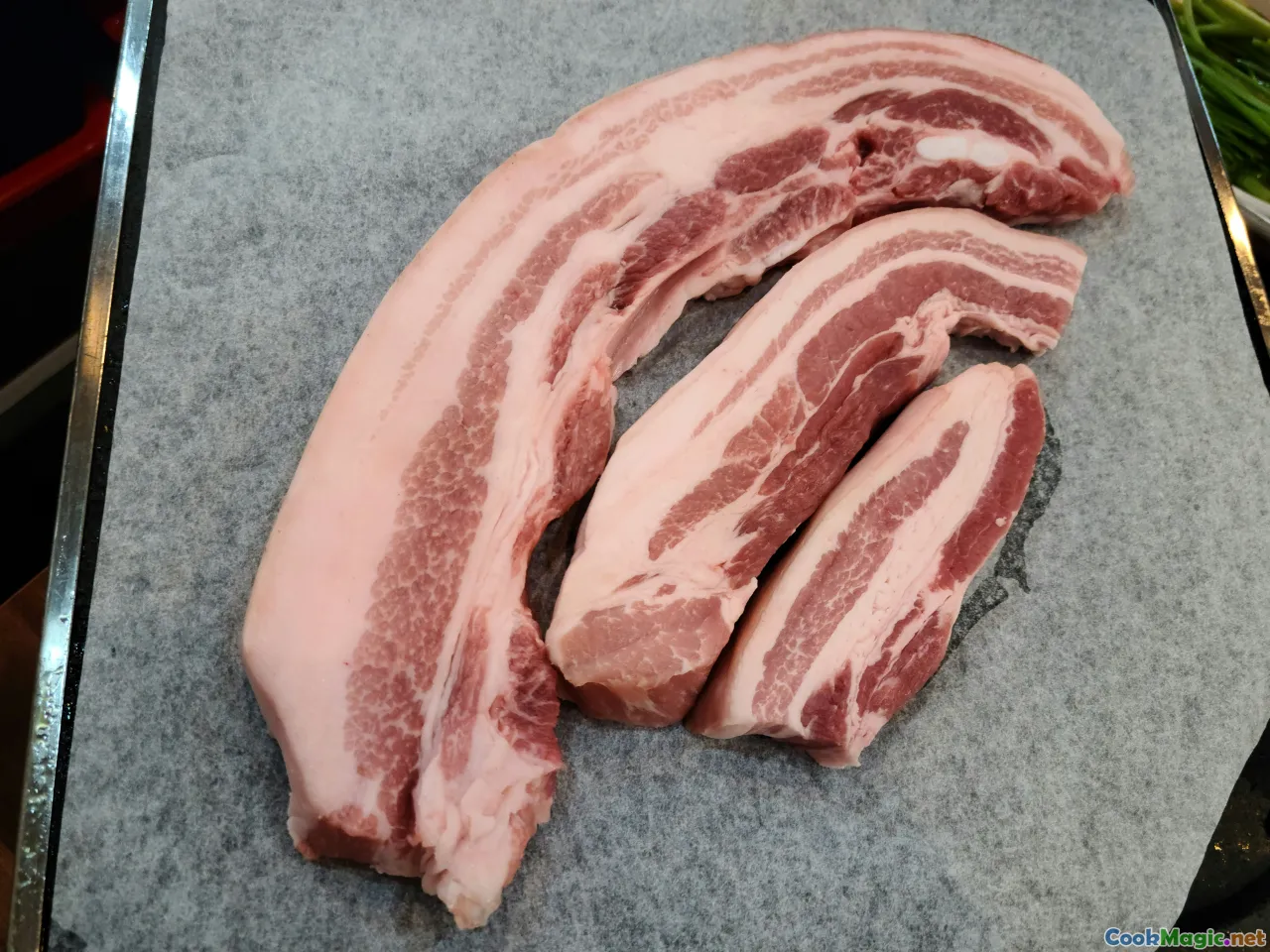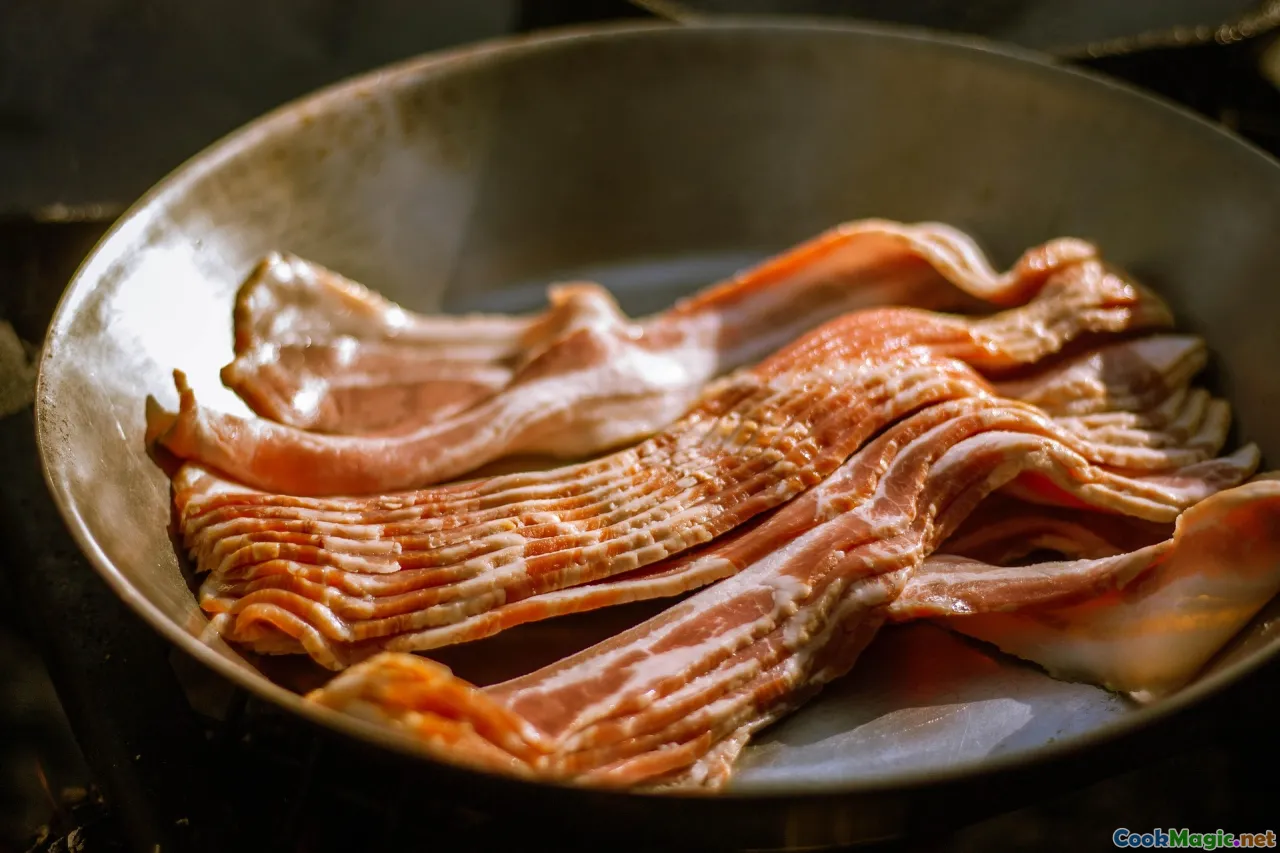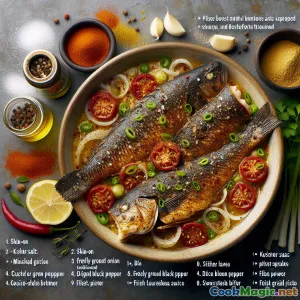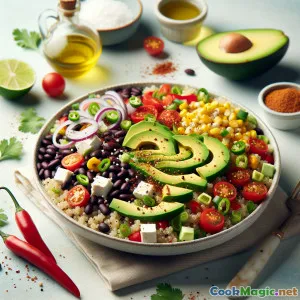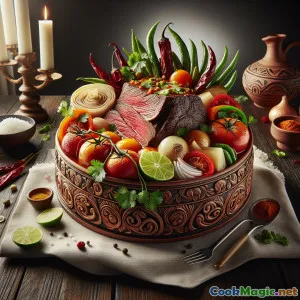
Daun Kolard Gaya Selatan dengan Bacon Renyah
(Southern Skillet Collard Greens with Crispy Bacon)
(0 Ulasan)0
866
Juli 16, 2025
Laporkan Masalah
Bahan
-
500 grams Daun collard
(Daun segar, batang tebal dibuang dan dicincang)
-
150 grams Bacon
(diasapi, dipotong kecil-kecil)
-
1 medium Bawang bombay kuning
(Dicincang halus)
-
3 cloves Bawang Putih
(Cincang)
-
2 tbsp Cuka sari apel
(Memberi kilau pada sayuran hijau.)
-
400 ml Kaldu Ayam
(Dapat digantikan dengan kaldu sayur untuk opsi vegetarian.)
-
1 tbsp Minyak zaitun
(Meningkatkan cita rasa, terutama untuk membuat bacon renyah.)
-
0.5 tsp Serpihan cabai merah
(Opsional, untuk sentuhan pedas yang ringan.)
-
0.5 tsp Garam
(Cicipi; sesuaikan jika perlu.)
-
0.5 tsp Lada hitam
(Baru dihancurkan atau digiling)
(Daun segar, batang tebal dibuang dan dicincang)
(diasapi, dipotong kecil-kecil)
(Dicincang halus)
(Cincang)
(Memberi kilau pada sayuran hijau.)
(Dapat digantikan dengan kaldu sayur untuk opsi vegetarian.)
(Meningkatkan cita rasa, terutama untuk membuat bacon renyah.)
(Opsional, untuk sentuhan pedas yang ringan.)
(Cicipi; sesuaikan jika perlu.)
(Baru dihancurkan atau digiling)
Nutrisi
- Porsi: 4
- Ukuran Porsi: 1 mangkuk (200g)
- Calories: 195 kcal
- Carbohydrates: 10 g
- Protein: 11 g
- Fat: 12 g
- Fiber: 4 g
- Sugar: 2 g
- Sodium: 550 mg
- Cholesterol: 25 mg
- Calcium: 130 mg
- Iron: 1.8 mg
Instruksi
-
1 - Siapkan daun collard.:
Keluarkan batang tebal dari daun collard. Bilas hingga bersih, kemudian tumpuk, gulung, dan iris daun menjadi pita tipis.
-
2 - Goreng bacon hingga garing:
Tambahkan minyak zaitun ke dalam wajan besar dengan api sedang. Goreng potongan bacon hingga renyah, sekitar 5–7 menit. Angkat dengan sendok berlubang dan sisihkan, biarkan lemak yang telah keluar tetap di dalam wajan.
-
3 - Tumis bawang bombay dan bawang putih:
Tambahkan bawang bombay yang dipotong dadu ke dalam wajan dengan lemak bacon. Tumis hingga bawang lunak, sekitar 3 menit, lalu aduk bawang putih selama 1 menit hingga harum.
-
4 - Masak daun kol hijau:
Tambahkan daun collard ke wajan. Aduk hingga terbalut rata, dan masak selama 2–3 menit. Tuang kaldu ayam, didihkan, tutup, dan masak 10–12 menit, aduk sesekali, hingga daun hijau lunak.
-
5 - Bumbui dan tambahkan bacon.:
Keluarkan tutupnya. Aduk dalam cuka sari apel, serpihan cabai merah (jika digunakan), garam, dan lada hitam. Kembalikan bacon ke dalam wajan dan aduk semua bahan dengan baik. Didihkan tanpa tutup hingga sebagian besar cairan menguap.
-
6 - Sajikan:
Cicipi untuk menyesuaikan bumbu, kemudian pindahkan collard greens dengan bacon ke mangkuk saji. Sajikan panas sebagai lauk pendamping atau makan siang yang mengenyangkan.
Keluarkan batang tebal dari daun collard. Bilas hingga bersih, kemudian tumpuk, gulung, dan iris daun menjadi pita tipis.
Tambahkan minyak zaitun ke dalam wajan besar dengan api sedang. Goreng potongan bacon hingga renyah, sekitar 5–7 menit. Angkat dengan sendok berlubang dan sisihkan, biarkan lemak yang telah keluar tetap di dalam wajan.
Tambahkan bawang bombay yang dipotong dadu ke dalam wajan dengan lemak bacon. Tumis hingga bawang lunak, sekitar 3 menit, lalu aduk bawang putih selama 1 menit hingga harum.
Tambahkan daun collard ke wajan. Aduk hingga terbalut rata, dan masak selama 2–3 menit. Tuang kaldu ayam, didihkan, tutup, dan masak 10–12 menit, aduk sesekali, hingga daun hijau lunak.
Keluarkan tutupnya. Aduk dalam cuka sari apel, serpihan cabai merah (jika digunakan), garam, dan lada hitam. Kembalikan bacon ke dalam wajan dan aduk semua bahan dengan baik. Didihkan tanpa tutup hingga sebagian besar cairan menguap.
Cicipi untuk menyesuaikan bumbu, kemudian pindahkan collard greens dengan bacon ke mangkuk saji. Sajikan panas sebagai lauk pendamping atau makan siang yang mengenyangkan.
Informasi Lebih Lanjut: Daun Kolard Gaya Selatan dengan Bacon Renyah
Collard Greens with Bacon — Southern Tradition in Every Bite
Collard greens have a deeply rooted history in Southern American cuisine, stretching back over generations and oceans. Originating in Africa and Europe, leafy greens like collards became staple crops across the southern United States due to their resilient nature and hearty, nutritious leaves. Collard greens with bacon is an iconic dish—earthy greens slow-simmered until melt-in-your-mouth tender, enriched with smoky bacon, sweet onions, and spiked with a splash of vinegar to balance the richness.
History & Cultural Significance
For enslaved African Americans residing in the Antebellum South, collards were cultivated in gardens as essential sources of nutrition. Traditionally, they were slow-cooked with smoked meats (ham hocks, fatback, or bacon) to bring extra body and warmth, flavors that became emblematic of African American and Southern cuisine. Every Black family, and indeed, many white households in places like Georgia, the Carolinas, and Alabama developed their own approaches to seasoning, braising, and serving collard greens, often with personal or regional flourishes.
The custom of adding vinegar reflects West African cooking traditions, where acid is often used to brighten the intensity of long-cooked stews. Even today, a jar of peppered vinegar frequently sits on the table alongside greens.
Personal Tips & Notes
- Prepping the Greens: Always remove the thick center ribs—these don't tenderize well and can add unwanted bitterness. For speed, try stacking several leaves, rolling tightly, and slicing into 'chiffonade' style ribbons.
- Choosing Bacon: Use high-quality, smoky bacon for depth. Alternatively, try adding chopped smoked sausage or a ham hock for even more flavor, or opt for a plant-based bacon or smoked tofu for a vegetarian version.
- Simmering Liquid: Chicken stock gives a rounded base, but if making vegetarian, try mushroom or vegetable stock with a splash of smoked paprika.
- Final Touch: The table vinegar is traditional—pass a small bottle for diners wishing to add extra tang. Vinegar can cut through the greens' natural brassica bitterness and bacon's richness at the last second.
- Leftovers & Storage: These collard greens taste even better the next day. Refrigerate in an airtight container and enjoy within three days. Reheat gently over the stove with a splash of water or stock to restore moisture.
Creative Variations
For an intriguing, creative spin, add chopped sun-dried tomatoes or a pinch of brown sugar at the end for sweetness, or toss in a can of drained white beans to make a complete one-skillet meal. Chopped jalapeños roasted with bacon briefly or a sprinkle of toasted pecans over the top brings new depths and crunch. Steep collards in miso-infused broth for a unique global twist.
Beyond the Side — Serving Ideas
While classic Southern plates offer collards alongside cornbread, barbecue meats, or fried chicken, don’t hesitate to serve these as a main element for lunch over cheesy grits, as part of a rice bowl, or folded into a breakfast sandwich with egg. Their savory and comforting taste profile brings a warm balance at any time of day.
Quick Nutrition Glimpse
Collards bring potent doses of vitamins A, C, and K, calcium, and dietary fiber, supporting strong bones and digestion. Coupled with protein and healthy fats from bacon, this dish is a filling source of comfort-food nutrition.
The joyous blend of old-world culinary knowledge refined on this continent makes collard greens with bacon more than a recipe—it’s a celebration of history, resourcefulness, and flavor. Whether you grew up alongside a pot of simmering greens or you’re trying this Southern mainstay for the very first time, you’re partaking in a beloved legacy that links countless kitchens across centuries.


